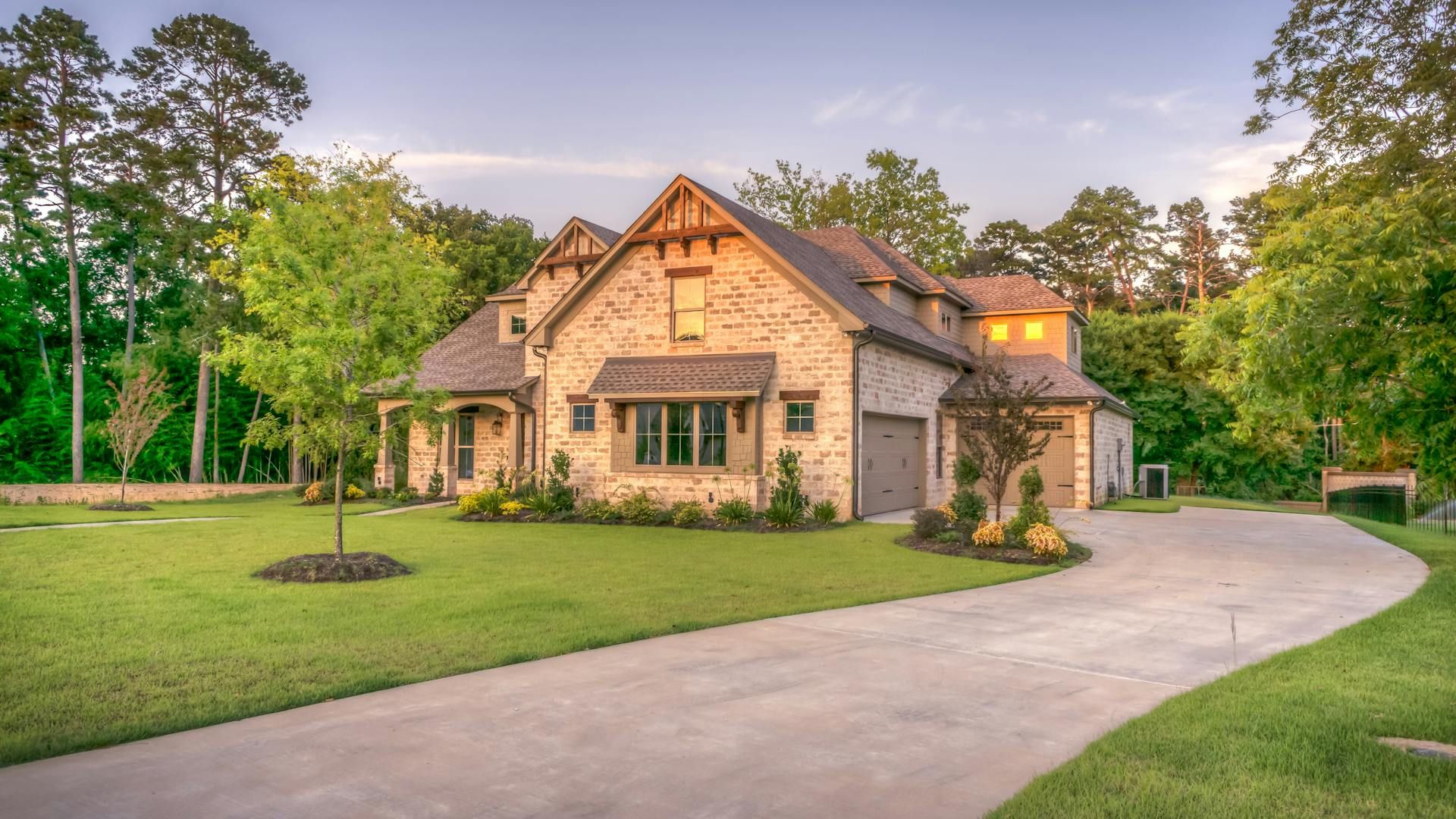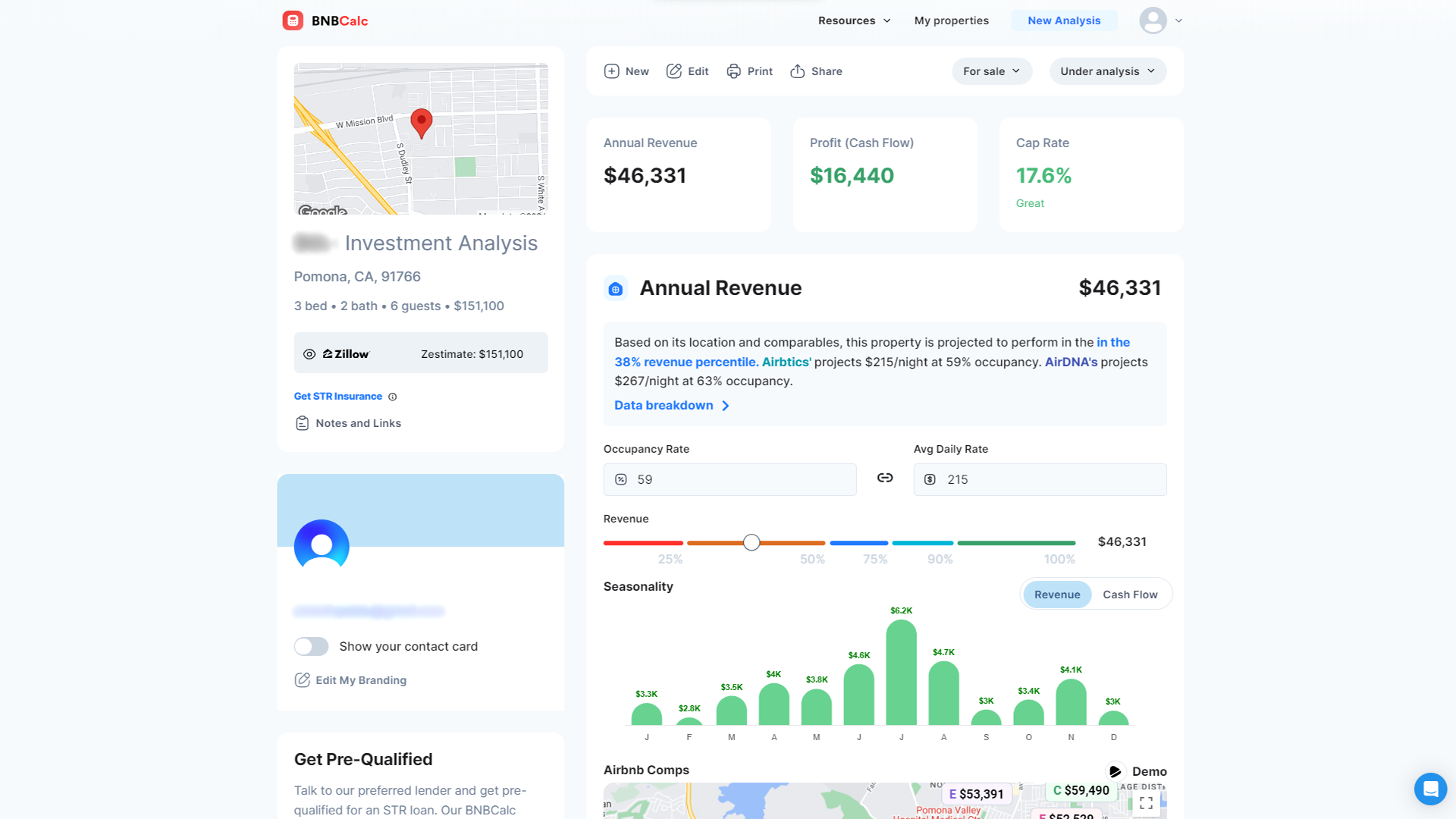Back
The Airbnb Investor's Guide to Gross Rent Multiplier

Written by:
Jeremy Werden
March 1, 2024

⚡️
Reveal any property's Airbnb and Long-Term rental profitability
Buy this property and list it on Airbnb.
This guide unlocks the secrets of gross rent multiplier, helping you estimate investment potential and identify profitable Airbnb ventures.
Ever dreamt of turning your property into a thriving Airbnb rental? Buckle up, aspiring Airbnb investor! This guide unlocks the secrets of the Gross Rent Multiplier (GRM), a powerful tool for navigating the dynamic world of short-term rentals.
We'll break down the GRM formula, showing you how to assess potential properties and estimate their profitability. But wait, there's more! We'll also explore the GRM's limitations and equip you with additional strategies to make informed investment decisions.
Ready to transform your Airbnb hosting ambitions into reality? Dive in and discover how the GRM can become your key to success in the exciting world of Airbnb rentals!
Understanding Gross Rent Multiplier
The Gross Rent Multiplier (GRM) is a critical metric in the realm of real estate investing, especially for Airbnb investors seeking to gauge the financial appeal of rental properties. At its core, GRM offers a straightforward way to compare the potential return on investment across different properties, using rental income as a key indicator of value. This section delves into the definition of GRM, how to calculate it, its application in real estate investing, and the advantages and limitations of relying on this metric.
Definition of GRM
The Gross Rent Multiplier is defined as the ratio of a property's price to its gross rental income. Essentially, it measures how many years it would take for the property to pay for itself in gross received rent. This simplicity makes GRM an attractive first-glance tool for investors to quickly assess a property's financial viability.
Gross Rent Multiplier Formula
The formula to calculate Gross Rent Multiplier is pretty straightforward:
GRM = Property Price/ Annual Gross Rental Income
To put this into perspective, if a property is priced at $300,000 and generates $30,000 in gross annual rent, the GRM would be 10. This means, theoretically, it would take 10 years for the property to pay for itself through rental income alone.
How GRM is Used in Real Estate Investing
In real estate investing, GRM serves as a quick filtering tool. Investors can use it to compare properties within the same market, identifying which ones offer a potentially higher return on investment.
A lower GRM can indicate a more attractive investment opportunity, suggesting that the property might generate sufficient rental income relative to its price. It's particularly useful for screening properties in the early stages of investment analysis.
Advantages and Limitations of Using GRM
The primary advantage of GRM lies in its simplicity and speed. It allows investors to quickly compare multiple properties without getting bogged down in detailed financial analysis. This can be particularly useful in markets where opportunities need to be assessed rapidly.
However, GRM also has its limitations. It does not account for operating expenses, vacancies, or capital expenditures, all of which can significantly impact the net income and, consequently, the real return on investment. Additionally, GRM does not consider financing costs, which can vary widely among properties and investors.
The Relevance of GRM to Airbnb Investments
The landscape of real estate investment has been significantly transformed by the advent of Airbnb, creating unique opportunities and challenges for investors. Understanding the Gross Rent Multiplier (GRM) within this context is crucial, especially given the distinct dynamics of short-term rentals compared to traditional long-term leasing.
This section explores the differences between these two investment strategies, underscores why GRM is a vital metric for Airbnb investors and examines factors that influence GRM for Airbnb properties.
Differences Between Traditional Rentals and Airbnb Investments
Traditional rental investments typically involve long-term leases, offering steady, predictable income and lower turnover costs.
In contrast, Airbnb investments cater to short-term rentals, characterized by higher income potential but also greater operational complexities, including higher maintenance costs, more intensive property management, and greater income volatility due to seasonal demand fluctuations.
Why GRM is a Critical Metric for Airbnb Investors
For Airbnb investors, GRM takes on heightened importance due to these unique operational characteristics. It provides a quick snapshot of the property's income-generating potential relative to its price.
Given the higher gross rental incomes typically associated with short-term rentals, GRM can help investors quickly identify properties that are likely to offer a better return on investment in the bustling Airbnb market.
Factors Affecting GRM in the Context of Airbnb Properties
Several factors can influence the GRM of Airbnb properties, making it different from traditional rental properties:
- Location: Properties in high-demand tourist or business destinations can command higher rental rates, potentially lowering the GRM and indicating a more favorable investment.
- Seasonality: Airbnb properties may experience significant fluctuations in occupancy and rental rates throughout the year, affecting the annual gross income and, consequently, the GRM.
- Operational Efficiency: Effective management of an Airbnb property, including minimizing vacancies and controlling expenses, can enhance gross rental income, impacting the GRM positively.
- Regulatory Environment: Local regulations regarding short-term rentals can affect the feasibility and profitability of Airbnb investments, influencing the GRM by altering potential income streams.
Calculating GRM for Airbnb Properties
For Airbnb investors, accurately calculating the Gross Rent Multiplier (GRM) is pivotal in assessing the potential profitability and value of short-term rental properties. This process involves a blend of straightforward arithmetic and nuanced understanding of market dynamics.
Below, we present a step-by-step guide to calculating GRM for an Airbnb investment, illustrate this with example calculations using real-world data, and delve into what constitutes a "good" GRM in different markets.
Step-by-Step Guide to Calculating GRM for an Airbnb Investment
Step 1 Gather Data
Start by collecting data on the annual gross rental income of the Airbnb property. This involves estimating the total income the property will generate over a year, accounting for peak seasons, potential vacancies, and any other factors that might influence occupancy rates.
Step 2 Determine Property Price
Identify the current market price or the purchase price of the property. This figure should encompass all acquisition costs, including any fees or repairs necessary to prepare the property for rental.
3 Apply the GRM Formula
Utilize the GRM formula:
GRM = Property Price/ Annual Gross Rental Income
Divide the property price by the annual gross rental income to determine the GRM.
Example Calculations with Real-World Data:
Imagine an Airbnb property located in a popular tourist destination. The property is priced at $500,000, and after evaluating past performance and market trends, you estimate it can generate $75,000 in gross rental income annually.
Applying the GRM formula:
GRM = $500,000/$75,000 = 6.67
This result means it would theoretically take 6.67 years for the property to pay for itself through gross rental income alone.
How to Get a More Accurate Annual Gross Rental Income for Airbnb Properties

The GRM formula makes use of the annual gross rental income, which can be easy to find for long-term rental properties. However, Airbnb hosts are targeted at more short-term customers, which can make it difficult to estimate an accurate annual gross rental income.
However, BNBCalc.com can help you get a realistic projected annual revenue for properties you haven't even bought yet. This can make it an extremely helpful tool if you're planning to purchase a property to rent out on Airbnb.
All you have to do is enter the address, purchase price, bedrooms, bathrooms, and how many persons it can accommodate, and you'll automatically get an annual gross revenue calculation, along with other important metrics.
Understanding What Constitutes a "Good" GRM in Various Markets
A "good" GRM can vary widely depending on several factors, including the property's location, the local real estate market's health, and the specific dynamics of the Airbnb market in that area. Generally, a lower GRM indicates a potentially more attractive investment, as it suggests a shorter time frame for the property to pay for itself through rental income.
- Market Comparisons: In high-demand areas where short-term rentals are popular, a GRM between 4 and 7 might be considered good due to the higher potential for rental income. In contrast, in markets with lower demand or stricter regulations on short-term rentals, a good GRM might be slightly higher, reflecting the decreased income potential.
- Investment Goals: Your investment strategy also plays a crucial role in determining what a good GRM is for you. If you prioritize quick returns, you may look for properties with a lower GRM. Conversely, if you're focused on long-term growth or appreciation, a slightly higher GRM might be acceptable, especially if the property is in a market with strong growth potential.
- Market Research: Conducting thorough market research is essential to understand the typical GRM ranges in your target investment area. Comparing GRMs across similar properties can help identify what constitutes a competitive and attractive GRM in that specific market.
Enhancing Your Airbnb Investment's GRM
Improving the Gross Rent Multiplier (GRM) of your Airbnb property is a strategic endeavor that focuses on increasing rental income, reducing operational costs, and optimizing occupancy rates and pricing strategies.
These enhancements can significantly impact the property's profitability and attractiveness as an investment. Below are targeted strategies and tactics aimed at boosting your Airbnb's GRM.
Strategies to Improve the Rental Income of Your Airbnb Property
Optimize Your Listing
High-quality photos, detailed descriptions, and highlighting unique amenities can make your listing stand out. Consider professional photography and an engaging narrative that showcases the best features of your property.
Add Value with Amenities
Amenities such as high-speed internet, a workspace, or offering experiences like local tours can increase your property's appeal. Unique or high-demand features can justify higher rental prices.
Dynamic Pricing
Utilize dynamic pricing tools to adjust your rates based on market demand, seasonality, and local events. Pricing competitively while maximizing income during peak times can significantly boost annual revenue.
Cost Reduction Tactics to Enhance Overall GRM
Streamline Operations
Automate guest communication, check-ins, and check-outs to reduce the need for hands-on management. Investing in smart locks or a key safe can save time and money.
Energy Efficiency
Implementing energy-efficient solutions such as LED lighting, smart thermostats, and energy-efficient appliances can reduce utility costs. These measures not only cut expenses but also appeal to environmentally conscious guests.
Regular Maintenance
Preventative maintenance reduces the likelihood of costly emergency repairs. Regularly servicing HVAC systems, plumbing, and appliances can extend their lifespan and reduce overall operating costs.
Importance of Occupancy Rates and Pricing Strategies
The occupancy rate is a critical factor in the profitability of an Airbnb investment. A high occupancy rate ensures a steady income stream, positively affecting the GRM. However, balancing occupancy with optimal pricing is key; too low prices might increase occupancy but decrease overall income, while too high prices could lead to lower occupancy rates.
Understand the high and low seasons in your market and adjust your pricing strategy accordingly. Offering discounts during off-peak times can help maintain a steady occupancy rate.
Monitor your competition and be responsive to changes in the market. Adjusting prices based on competitor pricing, last-minute bookings, and length of stay can optimize your revenue and occupancy rates.
Beyond GRM: Other Key Metrics for Airbnb Investors
While the Gross Rent Multiplier (GRM) provides a swift, initial glance at a property's financial viability, savvy Airbnb investors delve deeper, employing a suite of metrics to gain a comprehensive understanding of an investment's potential.
This section introduces three essential metrics beyond GRM: Net Operating Income (NOI), Cash on Cash Return, and Capitalization Rate (Cap Rate) offering a comparative analysis with GRM and guidance on using these metrics in tandem for a holistic investment analysis.
Net Operating Income (NOI)
NOI represents the annual income generated by the property after deducting all operational expenses except financing costs. It's a crucial metric for understanding the property's profitability on an operational level, providing insight into the efficiency of property management and the impact of operational strategies on the bottom line.
Cash on Cash Return
This metric measures the annual return on the cash invested in the property, considering the financing method used to acquire it. It's calculated by dividing the annual pre-tax cash flow by the total cash invested.
For Airbnb investors, this metric is invaluable for assessing the performance of their cash investment relative to other potential investment opportunities, taking into account the leverage effect of mortgages.
Cap Rate
The Cap Rate offers a snapshot of a property's yield in a specific timeframe, calculated by dividing NOI by the property's current market value. Unlike GRM, which focuses on gross income, Cap Rate provides insight into the profitability of a property after operating expenses, offering a deeper analysis of investment performance.
Comparative Analysis with GRM
While GRM offers a quick, superficial analysis based on gross income, NOI, Cash on Cash Return, and Cap Rate, delve deeper into accounting for operational costs, financing methods, and the property's current market value.
GRM is best used for initial screenings, whereas these additional metrics provide a more detailed financial picture, which is crucial for making informed investment decisions.
Using a Combination of Metrics for Comprehensive Investment Analysis
A holistic investment analysis requires a balanced approach, leveraging GRM for initial screenings to narrow down potential properties quickly. Once a property passes the GRM test, investors should analyze NOI to understand operational profitability, Cash on Cash Return to assess the efficiency of their cash investment, and Cap Rate to evaluate the investment's yield in the current market context.
Practical Tips for Prospective Airbnb Investors
Venturing into the Airbnb investment landscape requires more than just financial readiness; it involves thorough market research, an understanding of legal frameworks, and building a reliable team.
Here are practical tips for prospective Airbnb investors to navigate these critical areas effectively.
Conducting Market Research for Potential Airbnb Properties
- Investigate the demand for short-term rentals in your target area. Look at the occupancy rates of existing Airbnbs, focusing on peak and off-peak seasons. Analyze your competition to understand the amenities they offer and their pricing strategies.
- Pay attention to local economic indicators such as tourism trends, major events, and infrastructure developments that could influence demand for short-term rentals.
- Identify locations with high tourist or business visitor traffic. Proximity to attractions, restaurants, and transport hubs can significantly impact your occupancy rates and rental income.
Legal and Regulatory Considerations for Airbnb Investing
- Zoning Laws and Regulations: Check local zoning laws and regulations concerning short-term rentals. Some areas have restrictions or require special permits and licenses.
- Tax Obligations: Understand your tax obligations, including income tax on rental income and any local taxes applicable to short-term rentals.
- HOA Rules: If the property is part of a Homeowners' Association (HOA), review the HOA's rules regarding short-term rentals, as some have strict restrictions or bans.
Building a Team: Property Managers, Cleaners, and Other Essential Services
- Consider hiring a property manager experienced in short-term rentals. They can handle bookings, guest communication, and maintenance, freeing you to focus on growing your investment portfolio.
- Reliable and high-quality cleaning services are crucial for maintaining your property and ensuring guest satisfaction. Look for cleaning companies with experience in short-term rentals.
- Establish relationships with reliable handymen, plumbers, electricians, and other maintenance professionals. Quick and efficient handling of any issues is vital to keep your reviews positive and guests happy.
Wrapping Things Up
Mastering the Gross Rent Multiplier (GRM) equips you with a powerful tool to evaluate Airbnb investments. Remember, GRM is just one piece of the puzzle. Consider factors like location, competition, and local regulations. With a data-driven approach and informed decisions, you're well on your way to unlocking the potential of your Airbnb venture.
FAQs
What Is the Gross Rent Multiplier?
The Gross Rent Multiplier (GRM) is a real estate metric used to compare the value of rental properties. It calculates the ratio between the property's sale price and its gross rental income, providing a quick measure of the investment's value.
What Is the Formula for the Gross Rent Multiplier?
The formula for calculating the GRM is:
GRM = Property Price/ Annual Gross Rental Income
In word form, the GRM equals the property price divided by the annual gross rental income
This simple calculation offers investors a preliminary tool for evaluating the potential profitability of a property.
Why Is GRM Important?
GRM is important because it allows investors to quickly screen and compare potential rental properties based on their income-generating potential. A lower GRM indicates that a property could pay for itself in a shorter amount of time, making it a potentially more attractive investment.
What Is the Difference Between GRM and GIM?
While both GRM (Gross Rent Multiplier) and GIM (Gross Income Multiplier) assess property value relative to income, GRM focuses on gross rental income, whereas GIM considers the total gross income, including other income sources beyond rent. GIM provides a broader income perspective, making it suitable for properties with multiple income streams.
⚡️
Reveal any property's Airbnb and Long-Term rental profitability
Buy this property and list it on Airbnb.